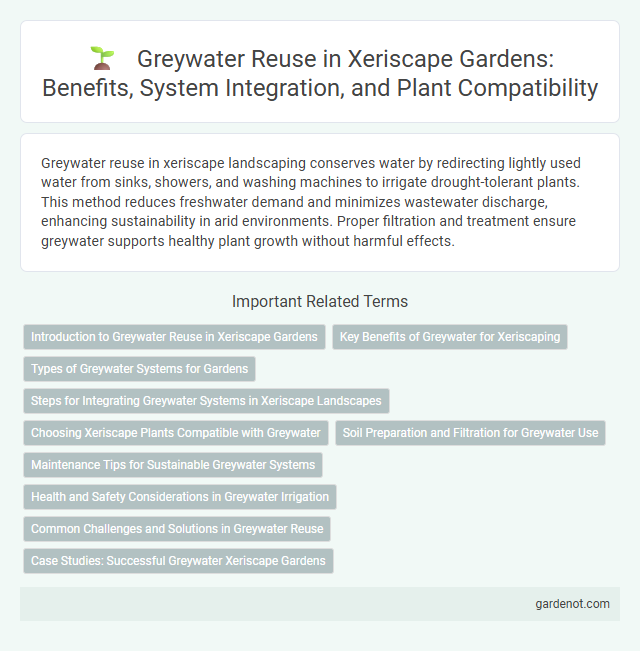Greywater reuse in xeriscape landscaping conserves water by redirecting lightly used water from sinks, showers, and washing machines to irrigate drought-tolerant plants. This method reduces freshwater demand and minimizes wastewater discharge, enhancing sustainability in arid environments. Proper filtration and treatment ensure greywater supports healthy plant growth without harmful effects.
Introduction to Greywater Reuse in Xeriscape Gardens
Greywater reuse in xeriscape gardens involves recycling lightly used water from household sources such as sinks, showers, and washing machines to irrigate drought-tolerant plants. This sustainable practice reduces freshwater consumption and supports water conservation by delivering nutrient-rich water directly to xeric landscapes. Incorporating greywater systems enhances xeriscaping efficiency while minimizing environmental impact in arid and semi-arid regions.
Key Benefits of Greywater for Xeriscaping
Greywater reuse significantly enhances xeriscaping by providing a sustainable water source that reduces dependence on municipal supply and conserves potable water. This practice supports healthy plant growth by delivering nutrient-rich water directly to soil, promoting deep root development and drought resilience. Utilizing greywater in xeriscaping lowers water bills and minimizes wastewater discharge, aligning with eco-friendly landscaping principles.
Types of Greywater Systems for Gardens
Greywater systems for gardens include laundry-to-landscape, simple branching drain, and pumped greywater systems, each designed to efficiently reuse water from household activities like laundry and bathing. Laundry-to-landscape systems redirect washing machine water to irrigate plants, while simple branching drain setups use gravity to distribute greywater across garden beds. Pumped systems deploy pumps to control water flow, suitable for larger landscapes requiring precise irrigation management and increased reuse capacity.
Steps for Integrating Greywater Systems in Xeriscape Landscapes
Implementing greywater systems in xeriscape landscapes involves first assessing local regulations and soil conditions to ensure compliance and system suitability. Next, design the irrigation layout to distribute greywater through subsurface drip lines or mulch basins, minimizing evaporation and contamination risks. Regular maintenance, including monitoring water quality and system components, is essential to optimize plant hydration and promote sustainable water reuse.
Choosing Xeriscape Plants Compatible with Greywater
Selecting xeriscape plants compatible with greywater reuse involves prioritizing species that tolerate variable water quality and occasional salt buildup. Native drought-resistant plants such as lavender, sage, and ornamental grasses thrive under greywater irrigation, ensuring sustainable growth without soil contamination. Proper plant selection enhances water conservation efforts while maintaining healthy landscapes in xeriscape gardening systems.
Soil Preparation and Filtration for Greywater Use
Effective soil preparation for greywater reuse in xeriscaping involves enhancing soil permeability and organic content to promote efficient filtration and prevent contamination. Incorporating sandy loam soils and organic matter improves greywater absorption while supporting microbial activity that breaks down contaminants. Proper filtration systems, such as gravel layers or constructed wetlands, further treat greywater before soil infiltration, ensuring safe and sustainable irrigation for drought-tolerant landscapes.
Maintenance Tips for Sustainable Greywater Systems
Routine inspection of greywater systems ensures efficient water flow and prevents clogs, preserving the sustainability of xeriscape irrigation. Using biodegradable soaps and avoiding harsh chemicals reduces pipe corrosion and protects plant health within greywater reuse setups. Regularly cleaning filters and monitoring soil moisture levels optimize system performance, maintaining water conservation in drought-tolerant landscaping.
Health and Safety Considerations in Greywater Irrigation
Greywater reuse in xeriscaping requires strict health and safety considerations to prevent contamination and the spread of pathogens. Proper filtration, disinfection methods such as chlorination or UV treatment, and avoiding contact with edible plants are essential to mitigate risks. Regular monitoring of water quality and adherence to local regulations ensure safe and sustainable irrigation practices.
Common Challenges and Solutions in Greywater Reuse
Greywater reuse in xeriscaping faces challenges such as potential contamination from household chemicals, clogging of irrigation systems due to solids, and regulatory restrictions on reuse practices. Effective solutions include installing proper filtration and treatment systems to ensure water quality, regular maintenance to prevent system blockages, and adhering to local guidelines to safely incorporate greywater for irrigation. Optimizing greywater reuse not only conserves freshwater resources but also supports sustainable landscaping in arid environments.
Case Studies: Successful Greywater Xeriscape Gardens
Greywater reuse in xeriscape gardens demonstrates significant water conservation benefits, as seen in case studies from arid regions like Arizona and California. These projects typically incorporate greywater systems that divert household wastewater from sinks and showers to irrigate drought-tolerant plants, reducing potable water consumption by up to 50%. Successful examples include urban residential gardens that maintain aesthetic landscaping while optimizing water efficiency through smart irrigation techniques and native xerophyte species.
Greywater reuse Infographic

 gardenot.com
gardenot.com